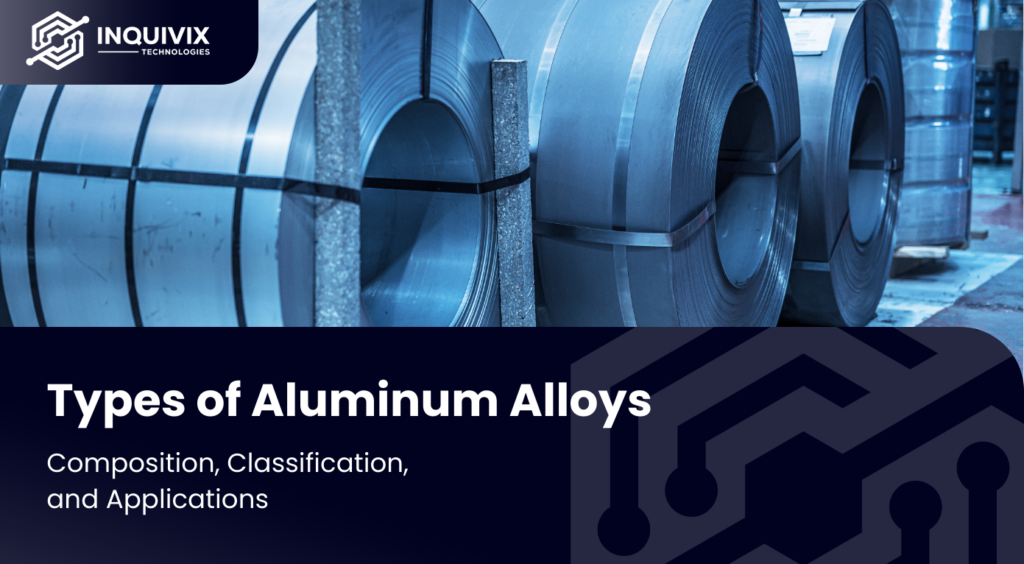
Introduction to Aluminum Alloys
Aluminum alloys are substances that have a role, in different sectors, like aviation, automobile, building and more. Made mostly of aluminum these alloys are reinforced by the inclusion of components improving their characteristics and expanding their usability.
Definition of Aluminum Alloys
Aluminum alloys are created by mixing aluminum with elements, like copper, silicon, magnesium, zinc and manganese. This combination alters the characteristics of aluminum to suit industrial requirements ranging from lightweight structural parts, to applications requiring high strength.
Importance in Various Industries
The use of aluminum alloys is pivotal across diverse sectors due to their unique combination of properties. These alloys offer excellent corrosion resistance, high electrical conductivity, and a favorable strength-to-weight ratio, making them ideal for applications where lightweight durability is essential.
Significance of Choosing the Right Alloy for Specific Applications
Selecting the appropriate aluminum alloy is critical to achieving optimal performance and longevity in various applications. Factors such as mechanical strength requirements, corrosion resistance, and thermal conductivity dictate the choice of alloy, underscoring the importance of understanding alloy characteristics and application-specific needs.
Understanding Aluminum Alloys
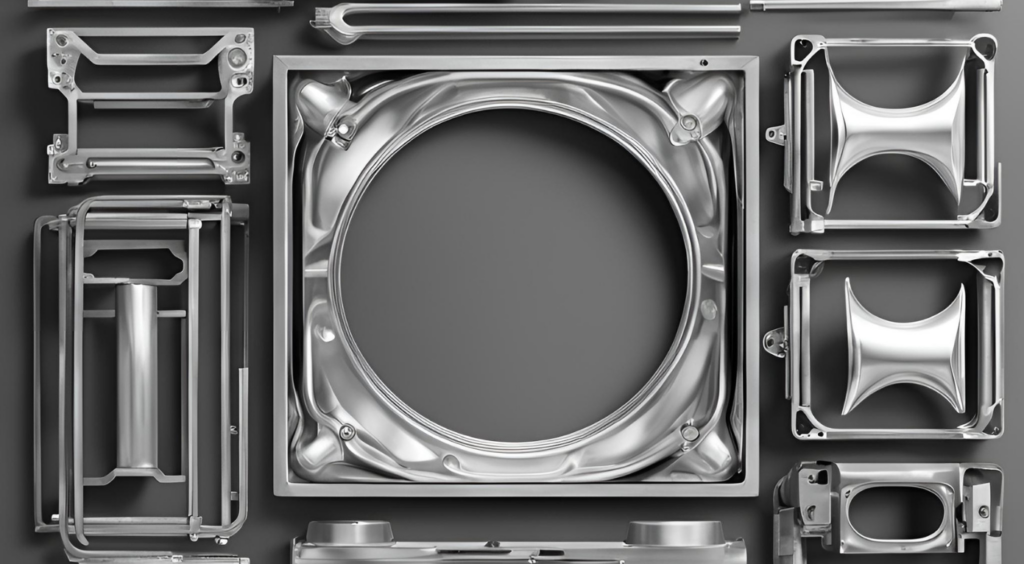
A. Types Based on Alloying Elements
1. Pure Aluminum Alloys
Pure aluminum alloys, designated in the 1000 series, are characterized by their high purity (typically 99% or higher) and excellent corrosion resistance. These alloys are primarily used where high electrical conductivity or formability is required, such as in electrical transmission lines and food packaging.
2. Aluminum-Copper Alloys
Aluminum-copper alloys, found in the 2000 series, incorporate copper as the primary alloying element. These alloys are renowned for their high strength-to-weight ratio and are extensively utilized in aerospace applications, where strength and fatigue resistance are critical.
3. Aluminum-Silicon Alloys
Aluminum-silicon alloys belong to the 4000 series and are known for their excellent casting properties, corrosion resistance, and minimal shrinkage during solidification. They are commonly used in automotive components and marine applications.
4. Aluminum-Magnesium Alloys
Aluminum-magnesium alloys, categorized in the 5000 series, offer good weldability, moderate-to-high strength, and excellent corrosion resistance, particularly in marine environments. These alloys are favored in structural applications requiring both strength and corrosion resistance.
5. Aluminum-Zinc Alloys
Aluminum-zinc alloys, part of the 6000 series, are among the strongest aluminum alloys available. They exhibit superior strength, toughness, and stress corrosion cracking resistance, making them suitable for aerospace and sporting equipment applications.
B. Types Based on Heat Treatment
1. Heat-Treatable Aluminum Alloys
Heat-treatable aluminum alloys, such as those in the 6000 series, can be strengthened through heat treatment processes like solution heat treatment and aging. These alloys offer a balance of strength and formability, making them versatile for applications ranging from structural components to consumer electronics.
2. Non-Heat-Treatable Aluminum Alloys
Non-heat-treatable aluminum alloys, found in the 3000 series, derive their strength from cold working or strain hardening processes rather than heat treatment. They are valued for their formability and corrosion resistance, commonly used in automotive body panels and household utensils.
Properties and Characteristics of Aluminum Alloys
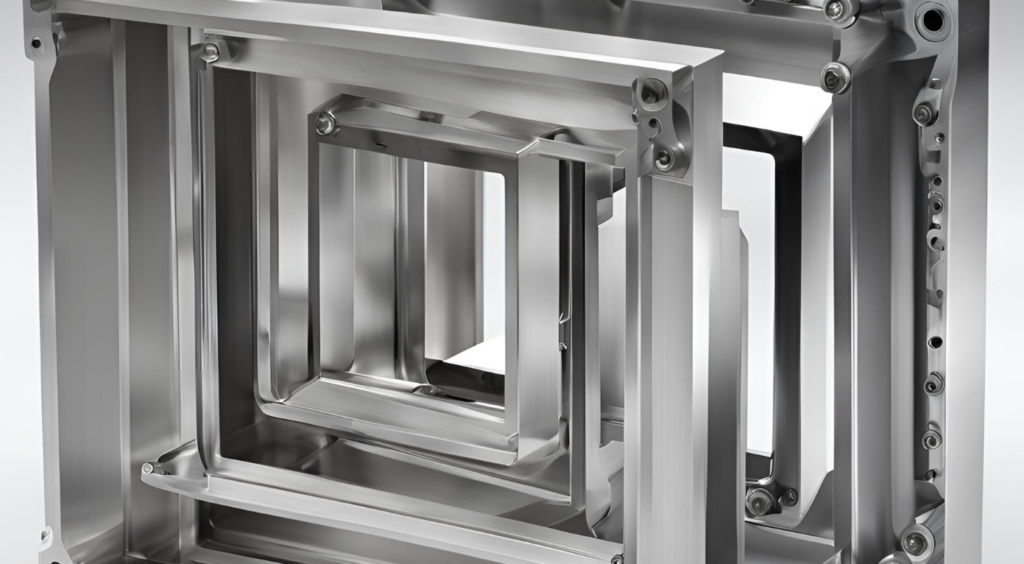
A. Mechanical Properties
Aluminum alloys exhibit a range of mechanical properties that make them suitable for diverse applications:
1. Tensile Strength and Yield Strength
Tensile strength varies significantly depending on the alloy type and heat treatment. For instance, high-strength alloys like those in the 7000 series offer excellent tensile strength suitable for structural applications.
Yield strength determines the stress level at which the material permanently deforms. Heat-treatable alloys typically exhibit higher yield strength after appropriate heat treatment processes.
2. Ductility and Formability
Aluminum alloys are generally ductile, allowing them to be formed into various shapes through processes like rolling, extrusion, and forging.
Formability varies among different alloys; for instance, pure aluminum and some wrought alloys are highly formable, whereas cast alloys may have limitations due to their crystalline structure.
B. Physical Properties
Understanding the physical properties of aluminum alloys is crucial for selecting the right material for specific applications:
1. Density and Lightweight Characteristics
Aluminum alloys are lightweight, with densities typically ranging from 2.7 to 2.9 g/cm³, making them ideal for applications where weight reduction is critical, such as aerospace and automotive industries.
2. Melting Point and Thermal Conductivity
The melting point of aluminum alloys varies depending on the alloy composition and can range from 600°C to 660°C. This moderate melting point facilitates casting and fabrication processes.
Aluminum alloys have excellent thermal conductivity, approximately four times higher than steel, making them suitable for heat exchangers and other thermal management applications.
C. Chemical Properties

Aluminum alloys possess diverse chemical properties that play a crucial role in their performance and suitability for various applications. One of the key attributes is their corrosion resistance. Aluminum alloys naturally develop a protective oxide layer on their surface when exposed to air, enhancing their resistance to corrosion. This oxide layer’s thickness and composition can vary depending on the alloy’s specific formulation and environmental conditions. Alloys enriched with elements like zinc, magnesium, and chromium exhibit superior corrosion resistance, making them suitable for marine environments, industrial applications, and outdoor structures where durability is paramount.
Another critical aspect is the reactivity of aluminum alloys with other metals. Some alloy compositions may experience galvanic corrosion when in contact with dissimilar metals, necessitating careful material selection and surface treatment strategies to prevent degradation over time. Engineers carefully balance alloying elements to mitigate these issues, ensuring long-term performance and reliability in complex engineering environments.
Chemical stability is also essential in evaluating aluminum alloys’ performance under various operating conditions. These alloys generally exhibit high chemical stability, minimizing the risk of chemical reactions that could compromise their structural integrity or performance over time. Specialized alloys designed for high-temperature applications or aggressive chemical environments undergo rigorous testing to validate their stability and resilience against chemical degradation.
The environmental sustainability of aluminum alloys is a significant consideration in modern manufacturing practices. These alloys are highly recyclable, offering significant energy savings compared to primary production methods. This recyclability makes aluminum alloys a preferred choice for industries aiming to reduce their environmental footprint and adopt sustainable practices. Regulatory standards ensure compliance with health and safety guidelines, particularly in applications such as food packaging, pharmaceuticals, and medical devices, where biocompatibility and non-toxicity are critical requirements.
Applications Across Industries
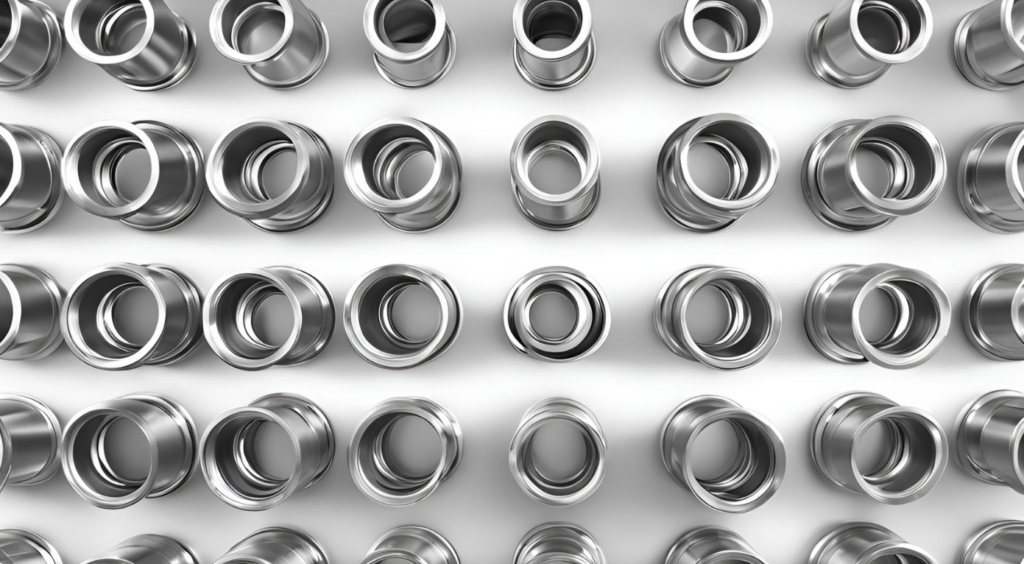
Aluminum alloys find extensive applications across diverse industries due to their unique combination of properties, making them indispensable in modern manufacturing and construction.
1. Aerospace and Automotive Industries
In the aerospace sector, aluminum alloys are favored for their exceptional strength-to-weight ratio, contributing to fuel efficiency and performance in aircraft components. These alloys are used in aircraft structures, wings, fuselage panels, and interior fittings, where lightweight materials are critical for reducing overall weight without compromising structural integrity. Similarly, in the automotive industry, aluminum alloys play a crucial role in reducing vehicle weight to improve fuel efficiency and meet stringent emission standards. They are employed in engine blocks, transmission housings, suspension components, and body panels, enhancing vehicle performance and durability.
2. Construction and Architecture
Architectural aluminum alloys are prized for their aesthetic appeal, corrosion resistance, and structural integrity, making them ideal for building facades, window frames, and structural components in skyscrapers and residential buildings. These alloys offer design flexibility, enabling architects to create innovative and sustainable structures while meeting performance requirements for safety and durability. In construction, aluminum alloys are used in bridges, stadiums, and infrastructure projects where their lightweight properties and high strength-to-weight ratio contribute to cost-effective and sustainable building solutions.
3. Industrial Applications
In industrial settings, aluminum alloys are essential for manufacturing equipment and machinery requiring corrosion resistance, thermal conductivity, and mechanical strength. They are utilized in heat exchangers, pressure vessels, and power transmission lines due to their excellent thermal and electrical conductivity properties. Aluminum alloys also play a critical role in the production of consumer electronics, such as laptops, smartphones, and tablets, where lightweight materials with superior thermal management capabilities are essential for optimal performance and user experience.
Choosing the Right Aluminum Alloy

Choosing the appropriate aluminum alloy involves a thoughtful assessment of several critical factors tailored to specific application needs and performance requirements.
1. Factors to Consider
Mechanical Requirements: Selecting the right alloy begins with evaluating mechanical properties such as tensile strength, yield strength, and ductility. Industries like aerospace and automotive prioritize alloys with high strength-to-weight ratios to enhance performance while reducing overall weight, improving fuel efficiency, and meeting stringent regulatory standards.
Corrosion Resistance: Assessing the environmental exposure is crucial. Alloys with added elements like zinc, magnesium, or chromium offer superior corrosion resistance, making them ideal for marine environments, outdoor structures, and industrial settings where durability and longevity are essential.
Weight Optimization: Industries benefit from lightweight alloys that maintain mechanical strength. High aluminum content alloys with low-density additives are favored in aerospace, automotive, and transportation sectors, where reducing mass enhances fuel efficiency and operational performance.
2. Market Specific Insights
Understanding regional market dynamics is pivotal, particularly in South Korea, where technological advancements and consumer preferences shape industry demands. Businesses must align alloy choices with local market requirements, leveraging insights into industry trends, regulatory standards, and environmental considerations to gain a competitive edge.
Case Studies and Best Practices: Illustrative examples highlight successful applications of specific aluminum alloys in South Korea. These examples showcase how alloys have addressed unique industry challenges, met performance benchmarks, and capitalized on emerging opportunities. By staying informed and collaborating with industry experts, businesses can strategically position themselves to meet evolving customer expectations and industry standards.
Types of Aluminum Alloys by Composition and Applications
Aluminum alloys are categorized based on their main alloying elements, which influence their properties and applications. Below is a breakdown of different types of aluminum alloys, their compositions, features, and common uses:
1000 Series (Commercially Pure Aluminum)
- Composition: 99% or higher pure aluminum
- Features: Excellent corrosion resistance, high thermal and electrical conductivity, good workability
- Uses: Electrical and chemical applications, food and chemical handling equipment, heat exchangers
2000 Series (Copper Alloys)
- Composition: 2-10% copper, sometimes with small amounts of magnesium, manganese, and iron
- Features: High strength, good machinability, lower corrosion resistance compared to other alloys
- Uses: Aerospace components, automotive parts, high-strength structural applications
3000 Series (Manganese Alloys)
- Composition: 1-1.5% manganese, with small amounts of iron, silicon, and copper
- Features: Good corrosion resistance, moderate strength, good formability
- Uses: Beverage cans, cooking utensils, roofing sheets, chemical equipment
4000 Series (Silicon Alloys)
- Composition: 4-12% silicon
- Features: High wear resistance, low expansion, good weldability, typically used in welding wire
- Uses: Welding and brazing filler materials, automotive engine components, architectural applications
5000 Series (Magnesium Alloys)
- Composition: 0.2-6% magnesium, with small amounts of chromium, manganese, silicon, and iron
- Features: Excellent corrosion resistance, high strength, good weldability
- Uses: Marine applications, automotive parts, pressure vessels, construction materials
6000 Series (Magnesium and Silicon Alloys)
- Composition: 0.8-1.2% magnesium, 0.4-1.2% silicon, sometimes with small amounts of copper and chromium
- Features: Medium strength, good corrosion resistance, excellent machinability, good weldability
- Uses: Structural applications, transportation, pipelines, architectural framing, marine components
7000 Series (Zinc Alloys)
- Composition: 1-8% zinc, with small amounts of magnesium and copper
- Features: Highest strength among aluminum alloys, good machinability, moderate corrosion resistance
- Uses: Aerospace and military applications, sporting goods, high-stress structural parts
8000 Series (Other Elements)
- Composition: Typically includes lithium and other elements
- Features: Varies widely based on specific alloy, can have unique properties like high strength-to-weight ratio
- Uses: Electrical cables, packaging, lithium-based alloys for aerospace applications
Example Alloys and Their Specific Uses:
- 2024 (2000 Series): Used in aircraft structures due to its high strength and fatigue resistance.
- 3003 (3000 Series): Commonly used in the manufacture of beverage cans.
- 4047 (4000 Series): Used for automotive and other manufacturing applications requiring good wear resistance and low expansion.
- 5052 (5000 Series): Used in marine environments, pressure vessels, and in the automotive industry.
- 6061 (6000 Series): Popular for structural applications, including bridges, buildings, and transportation systems.
- 7075 (7000 Series): Often used in aerospace applications for its high strength.
Each series offers a distinct balance of properties tailored for specific industrial needs, ranging from excellent machinability to superior corrosion resistance and high tensile strength.
Manufacturing and Fabrication Processes of Aluminum Alloys
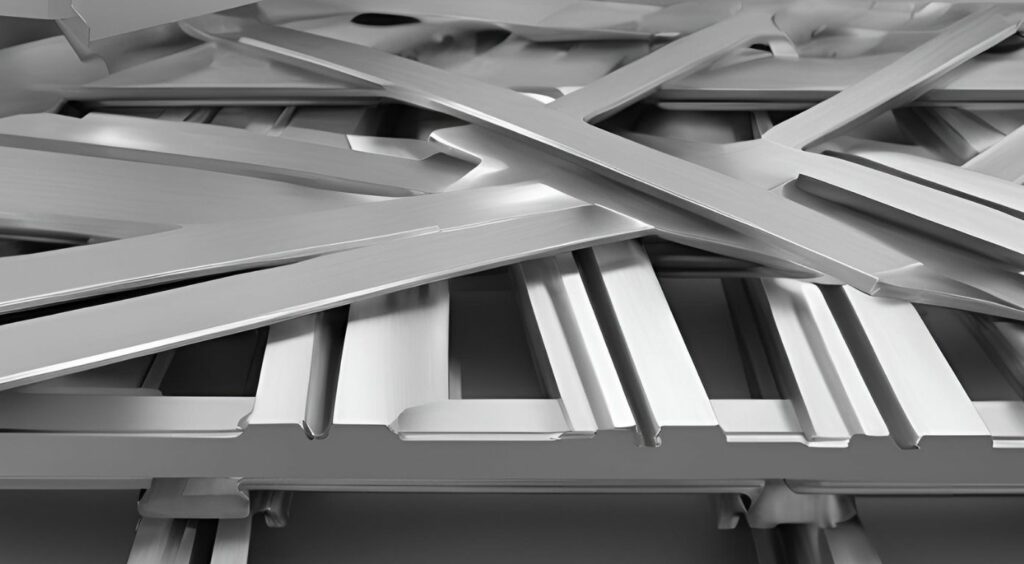
Aluminum alloys undergo distinct manufacturing and fabrication processes tailored to their intended applications and desired properties. These processes primarily involve casting and wrought processing methods.
A. Casting Aluminum Alloys
Casting involves pouring molten aluminum into molds to form complex shapes and components. This method is favored for its ability to produce intricate designs with uniform properties and good surface finish. It is commonly used in automotive parts, aerospace components, and architectural elements where specific shapes and detailed designs are required.
B. Wrought Aluminum Alloys
Wrought alloys are shaped through processes such as rolling, extrusion, forging, or machining from solid blocks or ingots. These methods enhance mechanical properties like strength and ductility compared to cast alloys. Wrought aluminum alloys find applications in structural components, consumer goods, and precision parts where high strength-to-weight ratio and formability are critical.
C. Heat Treatment Techniques
Heat treatment plays a crucial role in enhancing the mechanical properties of aluminum alloys, especially heat-treatable alloys.
1. Solution Heat Treatment
Solution heat treatment involves heating the alloy to a specific temperature to dissolve soluble elements, followed by rapid cooling to retain desired properties. This process improves mechanical properties such as strength and hardness, essential in aerospace, automotive, and industrial applications.
2. Aging (Precipitation) Heat Treatment
After solution heat treatment, aging heat treatment involves reheating the alloy to induce the formation of precipitates that further strengthen the material. This process enhances the alloy’s strength, hardness, and resistance to stress corrosion cracking, making it suitable for demanding applications in aerospace structures, marine environments, and high-performance sporting equipment.
D. Fabrication Techniques
Aluminum alloys are shaped and assembled using various fabrication techniques to meet specific design and performance requirements.
1. Welding and Joining
Welding methods like TIG, MIG, and friction stir welding (FSW) enable the assembly of aluminum parts with precision and strength, essential for automotive manufacturing, shipbuilding, and aerospace industries.
2. Machining and Forming
Machining processes such as milling, drilling, and turning are used to shape aluminum alloys into precise components with tight tolerances and superior surface finishes. These processes are critical in manufacturing consumer electronics, industrial machinery, and precision instruments.
Embracing the Future: Innovating with Aluminum Alloys

Aluminum alloys are at the forefront of modern manufacturing, offering a versatile range of properties that drive innovation across industries. From aerospace and automotive applications to construction and consumer electronics, these alloys enhance efficiency, durability, and performance in diverse sectors.
Applications Across Industries
In aerospace, aluminum alloys provide exceptional strength-to-weight ratios, crucial for aircraft components like wings and fuselage panels. Similarly, in automotive manufacturing, these alloys contribute to lightweight designs in engine blocks and body panels, improving fuel efficiency and meeting regulatory standards. Architectural applications benefit from aluminum alloys’ aesthetic appeal, corrosion resistance, and structural integrity in building facades, window frames, and structural components.
Manufacturing Excellence
Manufacturing and fabrication processes such as casting, wrought methods, and advanced heat treatments like solution and aging treatments ensure aluminum alloys meet stringent performance requirements. These processes produce components with enhanced mechanical properties, vital for aerospace structures, marine environments, and high-performance applications.
Strategic Alloy Selection
Choosing the right aluminum alloy involves evaluating mechanical properties, corrosion resistance, and weight optimization tailored to specific industry demands. Understanding market dynamics, including preferences in regions like South Korea, guides businesses in aligning alloy choices with local regulations and market needs, fostering competitiveness and innovation.
Future Outlook
Continued advancements in alloy development and ongoing research will shape the future of aluminum alloys across industries. By staying informed and adaptable, businesses can capitalize on emerging opportunities and maintain leadership in sustainability and performance.
Frequently Asked Questions
There are six main types of aluminum alloys: 1xxx series, 2xxx series, 3xxx series, 4xxx series, 5xxx series, and 6xxx series.
The 1xxx series is the purest form of aluminum, with a minimum purity of 99% aluminum. They are highly corrosion resistant and have excellent workability.
The 2xxx series contains copper as its main alloying element, making it strong and highly resistant to heat. These alloys are commonly used in aerospace applications.
The 3xxx series is commonly used in the construction, transportation, and electrical industries due to its high strength, good formability, and good corrosion resistance.
The 4xxx series contains silicon as its main alloying element, making it one of the easiest types to weld. These alloys are often used in the automotive industry.
The 5xxx series is known for its high strength and good formability, as well as its exceptional corrosion resistance. It is often used in marine environments and structural applications.
